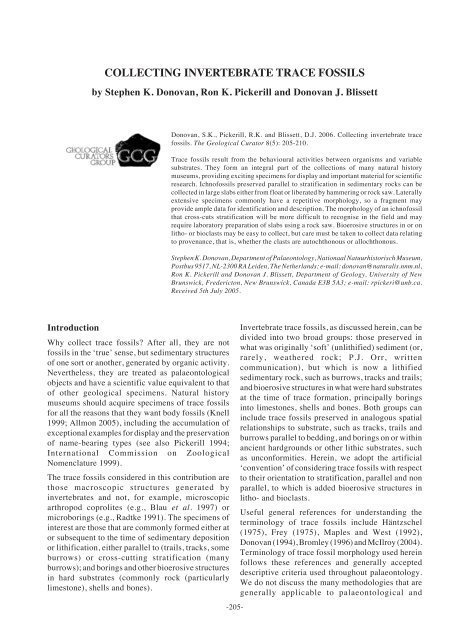Continental trace fossils and museum exhibits - Geological Curators ...
Continental trace fossils and museum exhibits - Geological Curators ...
Continental trace fossils and museum exhibits - Geological Curators ...
Create successful ePaper yourself
Turn your PDF publications into a flip-book with our unique Google optimized e-Paper software.
COLLECTING INVERTEBRATE TRACE FOSSILSby Stephen K. Donovan, Ron K. Pickerill <strong>and</strong> Donovan J. BlissettDonovan, S.K., Pickerill, R.K. <strong>and</strong> Blissett, D.J. 2006. Collecting invertebrate <strong>trace</strong><strong>fossils</strong>. The <strong>Geological</strong> Curator 8(5): 205-210.Trace <strong>fossils</strong> result from the behavioural activities between organisms <strong>and</strong> variablesubstrates. They form an integral part of the collections of many natural history<strong>museum</strong>s, providing exciting specimens for display <strong>and</strong> important material for scientificresearch. Ichno<strong>fossils</strong> preserved parallel to stratification in sedimentary rocks can becollected in large slabs either from float or liberated by hammering or rock saw. Laterallyextensive specimens commonly have a repetitive morphology, so a fragment mayprovide ample data for identification <strong>and</strong> description. The morphology of an ichnofossilthat cross-cuts stratification will be more difficult to recognise in the field <strong>and</strong> mayrequire laboratory preparation of slabs using a rock saw. Bioerosive structures in or onlitho- or bioclasts may be easy to collect, but care must be taken to collect data relatingto provenance, that is, whether the clasts are autochthonous or allochthonous.Stephen K. Donovan, Department of Palaeontology, Nationaal Natuurhistorisch Museum,Postbus 9517, NL-2300 RA Leiden, The Netherl<strong>and</strong>s; e-mail: donovan@naturalis.nnm.nl,Ron K. Pickerill <strong>and</strong> Donovan J. Blissett, Department of Geology, University of NewBrunswick, Fredericton, New Brunswick, Canada E3B 5A3; e-mail: rpickeri@unb.ca.Received 5th July 2005.IntroductionWhy collect <strong>trace</strong> <strong>fossils</strong>? After all, they are not<strong>fossils</strong> in the ‘true’ sense, but sedimentary structuresof one sort or another, generated by organic activity.Nevertheless, they are treated as palaeontologicalobjects <strong>and</strong> have a scientific value equivalent to thatof other geological specimens. Natural history<strong>museum</strong>s should acquire specimens of <strong>trace</strong> <strong>fossils</strong>for all the reasons that they want body <strong>fossils</strong> (Knell1999; Allmon 2005), including the accumulation ofexceptional examples for display <strong>and</strong> the preservationof name-bearing types (see also Pickerill 1994;International Commission on ZoologicalNomenclature 1999).The <strong>trace</strong> <strong>fossils</strong> considered in this contribution arethose macroscopic structures generated byinvertebrates <strong>and</strong> not, for example, microscopicarthropod coprolites (e.g., Blau et al. 1997) ormicroborings (e.g., Radtke 1991). The specimens ofinterest are those that are commonly formed either ator subsequent to the time of sedimentary depositionor lithification, either parallel to (trails, tracks, someburrows) or cross-cutting stratification (manyburrows); <strong>and</strong> borings <strong>and</strong> other bioerosive structuresin hard substrates (commonly rock (particularlylimestone), shells <strong>and</strong> bones).-205-Invertebrate <strong>trace</strong> <strong>fossils</strong>, as discussed herein, can bedivided into two broad groups: those preserved inwhat was originally ‘soft’ (unlithified) sediment (or,rarely, weathered rock; P.J. Orr, writtencommunication), but which is now a lithifiedsedimentary rock, such as burrows, tracks <strong>and</strong> trails;<strong>and</strong> bioerosive structures in what were hard substratesat the time of <strong>trace</strong> formation, principally boringsinto limestones, shells <strong>and</strong> bones. Both groups caninclude <strong>trace</strong> <strong>fossils</strong> preserved in analogous spatialrelationships to substrate, such as tracks, trails <strong>and</strong>burrows parallel to bedding, <strong>and</strong> borings on or withinancient hardgrounds or other lithic substrates, suchas unconformities. Herein, we adopt the artificial‘convention’ of considering <strong>trace</strong> <strong>fossils</strong> with respectto their orientation to stratification, parallel <strong>and</strong> nonparallel, to which is added bioerosive structures inlitho- <strong>and</strong> bioclasts.Useful general references for underst<strong>and</strong>ing theterminology of <strong>trace</strong> <strong>fossils</strong> include Häntzschel(1975), Frey (1975), Maples <strong>and</strong> West (1992),Donovan (1994), Bromley (1996) <strong>and</strong> McIlroy (2004).Terminology of <strong>trace</strong> fossil morphology used hereinfollows these references <strong>and</strong> generally accepteddescriptive criteria used throughout palaeontology.We do not discuss the many methodologies that aregenerally applicable to palaeontological <strong>and</strong>
















